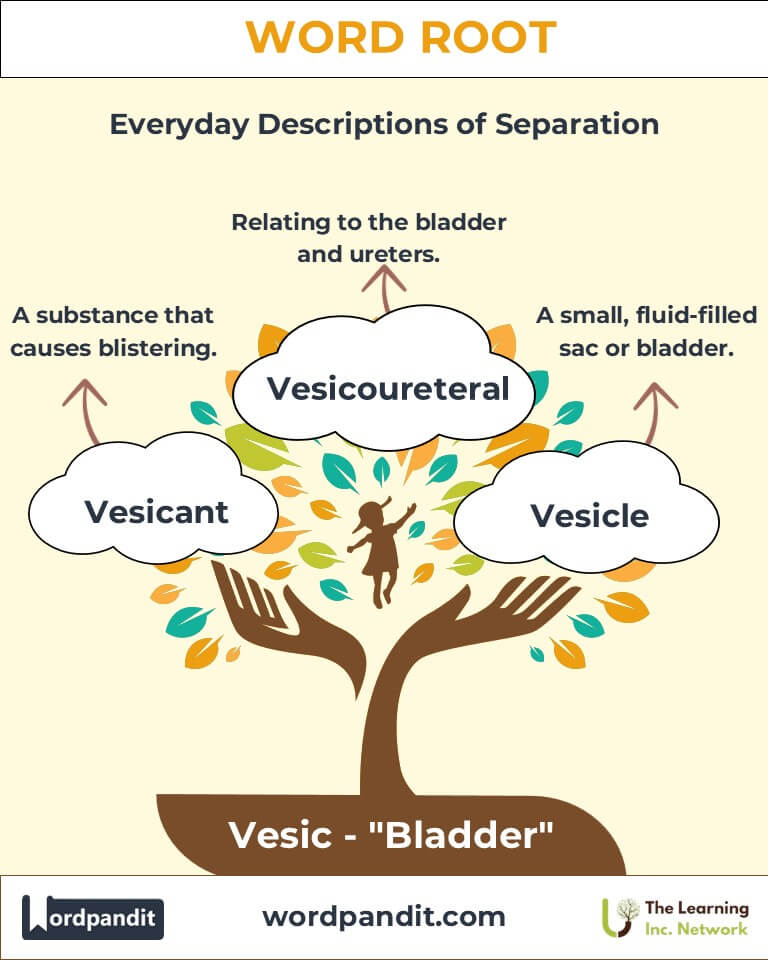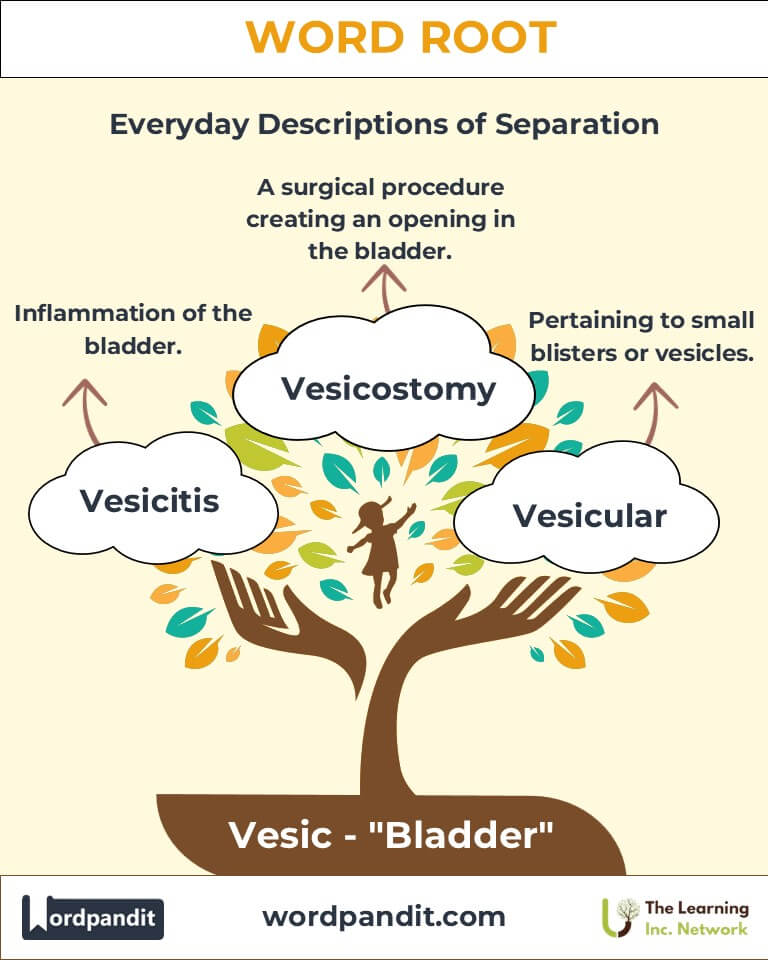Vesic: The Root of Fluid and Containment in Biology and Medicine
Byline:
Explore the fascinating word root "vesic", derived from the Latin "vesica," meaning "bladder." This root forms the foundation of essential terms in biology and medicine, such as "vesicle" and "vesicular," highlighting its significance in describing fluid-filled structures crucial to life.

Table of Contents
- Introduction: The Importance of Vesic
- Etymology and Historical Journey
- Mnemonic: Unlocking the Power of Vesic
- Common Vesic-Related Terms
- Vesic Through Time
- Vesic in Specialized Fields
- Illustrative Story: Vesic in Action
- Cultural Significance of the Vesic Root
- The Vesic Family Tree
- FAQs about the Vesic Word Root
- Test Your Knowledge: Vesic Word Root Quiz
- Conclusion: The Living Legacy of Vesic
1. Introduction: The Importance of Vesic
Pronounced "veh-sik," this Latin-rooted term plays a vital role in scientific vocabulary, especially in anatomy and cellular biology. From the vesicles that transport molecules in cells to medical descriptions of blisters and fluid-filled sacs, "vesic" captures the essence of structures that store or manage fluids in living organisms.

2. Etymology and Historical Journey
The word root "vesic" traces its origins to the Latin word vesica, meaning bladder or a small sac. Historically, this root was central to descriptions of anatomical and pathological structures involving fluid retention or transfer. As medical and biological sciences advanced, "vesic" became integral to describing both macroscopic and microscopic fluid-filled entities.
3. Mnemonic: Unlocking the Power of Vesic
To remember "vesic," picture a transparent balloon filled with water. It embodies the concept of a vesicle or bladder, containing and protecting fluids.
Mnemonic Device: "Vesic is like a vessel—a fluid-filled structure essential for life."
4. Common Vesic-Related Terms
- Vesicle (veh-sik-uhl):
- Definition: A small, fluid-filled sac within or outside a cell.
- Example: "Synaptic vesicles release neurotransmitters to communicate between neurons."
- Vesicular (veh-sik-yoo-lar):
- Definition: Relating to or consisting of vesicles.
- Example: "The vesicular texture of the rock indicated trapped gas during formation."
- Vesicant (veh-sik-uhnt):
- Definition: A substance causing blistering.
- Example: "Mustard gas acts as a vesicant, damaging the skin and mucous membranes."
- Vesicoureteral (veh-sik-yoo-ree-tuh-ral):
- Definition: Pertaining to the bladder and ureter.
- Example: "Vesicoureteral reflux occurs when urine flows backward into the ureters."
- Vesiculation (veh-sik-yoo-lay-shun):
- Definition: The formation of vesicles or blisters.
- Example: "Vesiculation of the skin is a common reaction to burns."
5. Vesic Through Time
- Early Usage: In ancient medicine, the term vesica referred to the bladder, a critical organ for waste excretion. Early anatomists used it to describe fluid-containing structures in the body.
- Modern Evolution: The root extended into cellular biology to describe vesicles, which play roles in secretion, transport, and storage within cells.
6. Vesic in Specialized Fields
- Cell Biology:
- Vesicle: Organelles transporting molecules like proteins and lipids across cellular compartments.
- Medicine:
- Vesicoureteral Reflux: A condition causing backward urine flow, leading to potential kidney damage.
- Dermatology:
- Vesicant: Chemicals that cause blistering, often studied in toxicology.
7. Illustrative Story: Vesic in Action
Dr. Elena was fascinated by vesicles in cellular communication. While studying synaptic vesicles in the brain, she discovered how these tiny sacs released neurotransmitters, enabling thought and memory. Her work not only advanced neuroscience but also inspired treatments for neurological disorders, demonstrating the profound impact of understanding "vesic."
8. Cultural Significance of the Vesic Root
While primarily scientific, "vesic" holds symbolic value in visual art and metaphor. Fluid-filled forms, such as bubbles or sacs, often represent containment, fragility, or life’s transient nature in cultural expressions.

9. The Vesic Family Tree
- Hydro (Greek: "water"):
- Examples: Hydrocephalus (excess fluid in the brain), Hydrate (to provide water).
- Cyst (Greek: "sac"):
- Examples: Cystic (relating to a bladder or sac), Cystitis (inflammation of the bladder).
- Vacu (Latin: "empty"):
- Examples: Vacuole (a storage structure in cells, often containing fluid).

10. FAQs About " Vesic "
Q: What does "vesic" mean?
A: The root "vesic" means "bladder" or "small fluid-filled sac," derived from the Latin "vesica." It is commonly used in medical and biological terminology to describe structures that contain or manage fluids.
Q: What are vesicles in cell biology?
A: Vesicles are small, membrane-bound sacs within cells that transport, store, or digest cellular materials. For example, synaptic vesicles in neurons carry neurotransmitters, while secretory vesicles transport proteins to the cell surface.
Q: What is the difference between a vesicle and a vacuole?
A: Vesicles are small, dynamic structures involved in transport and secretion, while vacuoles are larger, storage-oriented organelles typically found in plant cells, storing water, ions, or nutrients.
Q: What does a vesicant do?
A: A vesicant is a chemical or substance that causes blistering or damage to the skin and mucous membranes. For instance, mustard gas used in warfare is a vesicant, as it creates painful blisters on contact.
Q: What is vesicoureteral reflux?
A: This condition involves the backward flow of urine from the bladder into the ureters and sometimes the kidneys. It can lead to recurrent urinary tract infections and kidney damage if untreated.
Q: How does "vesiculation" occur in dermatology?
A: Vesiculation refers to the formation of blisters or vesicles on the skin, often caused by burns, chemical exposure, or certain skin diseases like eczema.
Q: Why is "vesic" significant in anatomy and medicine?
A: The root is crucial for describing anatomical structures (e.g., bladder) and pathological conditions (e.g., vesicoureteral reflux), as well as cellular components like vesicles, which play key roles in transporting substances within the body.
11. Test Your Knowledge: " Vesic " Mastery Quiz
1. What does the root "vesic" mean?
2. What is a vesicle in cell biology?
3. Which term describes a substance that causes blistering?
4. Which condition involves the backward flow of urine from the bladder to the ureters?
5. What is vesiculation in dermatology?
12. Conclusion: The Living Legacy of Vesic
The root "vesic" exemplifies the critical role of fluid-filled structures in biology and medicine. From cellular transport to organ function, its relevance spans disciplines and discoveries. Understanding "vesic" not only enriches our language but also deepens our appreciation for the intricate systems that sustain life.












